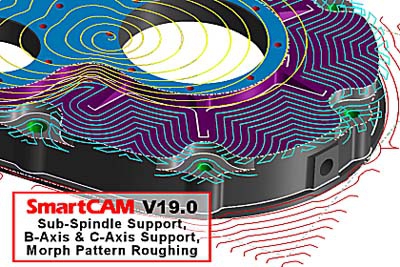
SmartCAMcnc has announced the release of SmartCAM V19.0. Version 19.0 delivers new and improved milling functionality to the SmartCAM milling suite, and several modeling and usability enhancements to the entire SmartCAM suite of computer-aided manufacturing (CAM) system software. The SmartCAM product family consists of applications for Computer-Numerical Control (CNC) milling, turning, fabrication and wire EDM.
SmartCAM Version 19.0 was conceived on three central themes: core milling improvements, core modeling improvements, and usability improvements requested by current SmartCAM customers.
The Region Roughing process introduced in SmartCAM V18 has been extended to offer a new Part Offset Roughing Pattern strategy. This new roughing method generates multiple offset profiling passes on any region configuration, including open or closed regions, with or without islands or voids. Roughing passes always progress from open stock boundaries or closed region centers toward the part profile. The resulting toolpath maintains the specified cut direction relative both the material and the part profile.
In addition to the new Part Offset roughing pattern, Version 19.0 extends the existing Spiral roughing pattern in all the roughing processes to include a new Spiral Stay-Down Roughing Option. When enabled, the stay-down behavior navigates from one "pinched off" region to another without retracting the tool and re-entering into stock. The resulting toolpath typically contains just one initial ramp to depth with the tool remaining at the cut level for the entire region, eliminating multiple retract and re-entry moves that would otherwise occur.
"For SmartCAM V19.0, we continued our development focus on the roughing improvements found in several of the recent SmartCAM releases. The new Part-Offset Pattern and Stay-Down Spiral Option allow far more efficient toolpaths to be automatically generated," said Douglas Oliver, SmartCAMcnc's Senior Product Manager. "Not only does this reduce programming and machining times, but tool life also will be greatly extended."
Several New Modeling Capabilities have been added to the SmartCAM v19 release. A new User Region function allows wireframe machining regions to be defined using any combination of part and stock profiles. User-defined region sets can then be passed to the Region Rough process for efficient machining using the captured part and stock definition.
The SmartCAM FreeForm Machining milling application receives a new Boundary Surface creation method that allows model voids or holes to be easily covered to exclude them during solid and surface machining processes. The Model Checking and Healing functionality is now available in all SmartCAM applications when opening or merging CAD models, and a new Model Validation tool has been added to improve access to the healing and reporting functionality.
Contact Details
Related Glossary Terms
- centers
centers
Cone-shaped pins that support a workpiece by one or two ends during machining. The centers fit into holes drilled in the workpiece ends. Centers that turn with the workpiece are called “live” centers; those that do not are called “dead” centers.
- computer-aided design ( CAD)
computer-aided design ( CAD)
Product-design functions performed with the help of computers and special software.
- computer-aided manufacturing ( CAM)
computer-aided manufacturing ( CAM)
Use of computers to control machining and manufacturing processes.
- electrical-discharge machining ( EDM)
electrical-discharge machining ( EDM)
Process that vaporizes conductive materials by controlled application of pulsed electrical current that flows between a workpiece and electrode (tool) in a dielectric fluid. Permits machining shapes to tight accuracies without the internal stresses conventional machining often generates. Useful in diemaking.
- gang cutting ( milling)
gang cutting ( milling)
Machining with several cutters mounted on a single arbor, generally for simultaneous cutting.
- milling
milling
Machining operation in which metal or other material is removed by applying power to a rotating cutter. In vertical milling, the cutting tool is mounted vertically on the spindle. In horizontal milling, the cutting tool is mounted horizontally, either directly on the spindle or on an arbor. Horizontal milling is further broken down into conventional milling, where the cutter rotates opposite the direction of feed, or “up” into the workpiece; and climb milling, where the cutter rotates in the direction of feed, or “down” into the workpiece. Milling operations include plane or surface milling, endmilling, facemilling, angle milling, form milling and profiling.
- profiling
profiling
Machining vertical edges of workpieces having irregular contours; normally performed with an endmill in a vertical spindle on a milling machine or with a profiler, following a pattern. See mill, milling machine.
- toolpath( cutter path)
toolpath( cutter path)
2-D or 3-D path generated by program code or a CAM system and followed by tool when machining a part.
- turning
turning
Workpiece is held in a chuck, mounted on a face plate or secured between centers and rotated while a cutting tool, normally a single-point tool, is fed into it along its periphery or across its end or face. Takes the form of straight turning (cutting along the periphery of the workpiece); taper turning (creating a taper); step turning (turning different-size diameters on the same work); chamfering (beveling an edge or shoulder); facing (cutting on an end); turning threads (usually external but can be internal); roughing (high-volume metal removal); and finishing (final light cuts). Performed on lathes, turning centers, chucking machines, automatic screw machines and similar machines.
- wire EDM
wire EDM
Process similar to ram electrical-discharge machining except a small-diameter copper or brass wire is used as a traveling electrode. Usually used in conjunction with a CNC and only works when a part is to be cut completely through. A common analogy is wire electrical-discharge machining is like an ultraprecise, electrical, contour-sawing operation.






